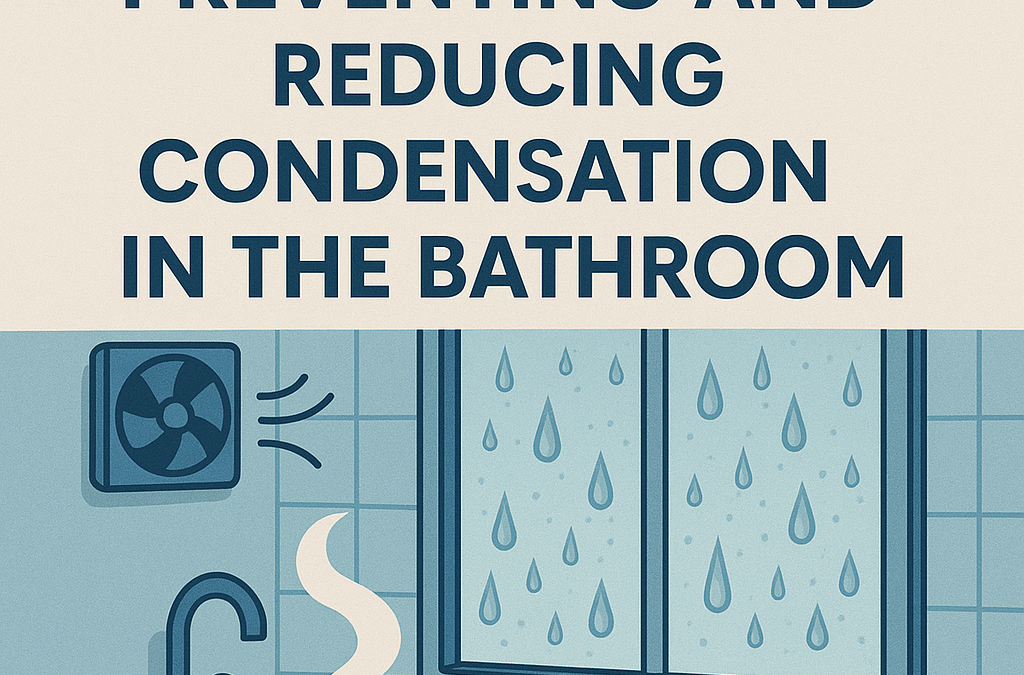Bathroom condensation is a common problem that can lead to a host of issues: mould growth, mildew, and a generally unpleasant environment, making it essential to prevent bathroom condensation. Not only is this unsightly, but it can also pose health risks, especially for those with respiratory sensitivities, as condensation can cause the growth of black mould.
In this comprehensive guide, we’ll delve into the root causes of bathroom condensation, explore effective prevention strategies, and offer practical tips to keep your bathroom fresh, clean, and free from moisture-related problems. Whether you’re a homeowner or a renter, these solutions are designed to improve your bathroom’s environment, enhance your overall well-being, and help eliminate mould.
Understanding the Enemy: What Causes Condensation?
Condensation occurs when warm, moist air, filled with water vapour, comes into contact with cold walls or surfaces, which can lead to condensation in your home. In the bathroom, this typically happens after a hot shower or bath, when the amount of moisture in the air increases significantly. As the warm, humid air hits the cooler tiles and walls, it condenses into water droplets – hence the foggy mirror and damp surfaces, which can lead to condensation in your home.
Winning the War: Strategies for Preventing and Reducing Condensation
1. Ventilation is Key
Open a window
This can help regulate humidity and allow moisture in the air to dissipate. Let the fresh air in by opening windows to help manage humidity and reduce the risk of condensation. Open a window whenever you shower or bathe to allow the moist air to escape.
Extractor Fan Power
An extractor fan can significantly help remove condensation and lower humidity levels. If you have an extractor fan, turn it on before showering and leave it running for at least 20 minutes afterwards to help reduce bathroom condensation and get rid of mould. This will help whisk away the moisture-laden air and reduce bathroom condensation.
Keep the Door Shut (For Now)
This helps contain humidity in the bathroom. Closing the bathroom door while showering traps the steam, preventing it from spreading to other parts of your home. But remember to open the door afterwards to allow the moisture to escape and reduce humidity levels.
2. Temperature Regulation
Warm Up the Room
Keeping your bathroom slightly warmer than the rest of your house can help reduce the temperature difference between the air and cold surfaces, minimizing condensation. Consider a heated towel rail or underfloor heating for a touch of luxury and to help avoid condensation.
Cooler Showers
We know, we know – who doesn’t love a steaming hot shower? But for the sake of your bathroom’s well-being, consider opting for slightly cooler showers.
3. Wiping Down and Squeegee Away
Post-Shower Swipe
Use a squeegee to remove excess moisture from surfaces and help stop bathroom condensation. After showering, take a few minutes to wipe down wet surfaces like tiles, mirrors, and shower screens with a microfiber cloth to remove condensation. This will remove excess moisture before it has a chance to condense.
Squeegee Savior
The squeegee is your best ally in the fight against moisture in the air and stopping condensation build-up on bathroom walls. Squeezing your shower screen after each use removes water droplets and reduces the surface area available for condensation, helping to manage humidity.
4. Landlord Property Maintenance Considerations
Some solutions, like installing extractor fans or heated towel rails, might require landlord approval to help deal with bathroom condensation and reduce the risk of mould growth. If you’re a renter, it’s always best to check your tenancy agreement or have a chat with your landlord before making any permanent changes.
5. Advanced Moisture-Fighting Techniques (for persistent problems)
Dehumidifier Duty
Manage humidity levels effectively to prevent excess moisture in the air and avoid condensation in your bathroom. For chronically damp bathrooms, a dehumidifier can be a lifesaver in the fight to stop bathroom condensation. It draws moisture from the air, preventing condensation and creating a more comfortable environment by reducing humidity.
Moisture-Resistant Materials
Moisture-resistant materials can help insulate your bathroom and prevent condensation. Consider talking to your landlord (if applicable) about installing moisture-resistant wall panels or condensation-reducing paint. These can help prevent mould growth and make your bathroom more resistant to condensation build.
Takeaway
Following these simple strategies, you can keep your bathroom condensation-free and create a fresh, inviting space to relax and unwind, while managing humidity levels and reducing the risk of mould. Remember, a little prevention goes a long way in combating the bathroom blues and maintaining a comfortable humidity level to avoid condensation.


Recent Comments